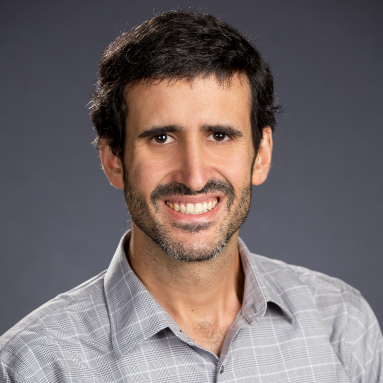Students pursuing a PhD in statistics tackle the deeper problems in statistics and apply them to real-world applications in academic settings and in industries as diverse as banking and healthcare.
As the need for skilled statisticians increases, WPI’s PhD in statistics offers a rigorous plan for students who enjoy the field’s challenges, who want to forge new paths, and who anticipate solving original problems. The program offers advanced coursework and research in statistics while imparting critical-thinking and problem-solving skills.
Students in this interdisciplinary program work closely with accessible faculty and often collaborate with researchers in data science, bioinformatics and computational biology, engineering, and business. Students demonstrate their competency at gathering vast amounts of numerical facts (data), evaluating it, and translating or presenting the findings and results for applications in various fields.
The knowledge gained in this program provides real-world opportunities for careers in data-driven industries. Companies use enormous amounts of data to help develop more targeted products. The healthcare industry has great need for statisticians who can help develop new drug technologies or conduct clinical trials. Students are supported in research that will solve puzzles and patterns in big data.

Curriculum
Students entering the program with a BS must successfully complete 90 semester hours of graduate work (students with an MS must complete 60 semester hours). At least 30 semester hours must be spent in dissertation research. Full-time residency at WPI is required for at least one continuous academic year of graduate work.
- General Courses (credited for students with MS), 30 credits
- Research Preparation Phase, 24-30 credits
- Research-related Courses or Independent Studies, 9-18 credits
- PhD Project, 1-9 credits
- Extra-departmental Studies, 6 credits
- Dissertation Research, at least 30 credits
- General Comprehensive Exam
- PhD project
- Preliminary Examination
- PhD Dissertation
Students entering with a BS must choose six statistical and mathematical courses from those listed below:
Statistical Courses
MA540 Probability and Mathematical Statistics I
MA541 Probability and Mathematical Statistics II
MA542 Regression Analysis
MA543 Statistical Methods for Data Science
MA546 Design and Analysis of Experiments
MA547 Design and Analysis of Observational and Sampling Studies
MA548 Quality Control
MA549 Analysis of Lifetime Data
MA550 Time Series Analysis
MA552 Distribution-free and Robust Statistical Methods
MA554 Applied Multivariate Analysis
MA556 Applied Bayesian Statistics
MA584 Statistical Methods in Genetics and Bioinformatics
Mathematical Courses
MA502 Linear Algebra
MA503 Lebesgue Measure and Integration
MA510 Numerical Methods
MA514 Numerical Linear Algebra
MA528 Measure Theoretic Probability Theory
You may consider completing approved independent studies work in advanced mathematical statistics, advanced multivariate statistics, advanced survey sampling, advanced linear model, generalized linear model, advanced Bayesian statistics, advanced time series, advanced measure-theoretical probability, or advanced statistical genetics.
Refer a Friend
Do you have a friend, colleague, or family member who might be interested in a WPI graduate program? Click below to tell them about our programs.
Research
Our PhD program is highly competitive, and it offers an excellent foundation for future scholars and leaders in statistics. Through rigorous and comprehensive training and research experiences in statistics and related areas, you’ll be ready for leadership roles in academia, industry, and government. WPI’s program requires you to sharpen your critical-thinking and problem-solving skills to address statistical challenges in data-related researches and applications.
WPI’s PhD students work alongside faculty and other PhD students and are involved in diverse projects, both fundamental and interdisciplinary, in these areas:
- Bayesian statistics, survey sampling, and small-area estimation with applications to health, economic, and agricultural data
- High-dimensional statistical learning for big data, including financial time series and spatial statistics
- Biostatistics, statistical genetics and genomics, and statistics in biomedical and clinical studies
- Order restricted inference and meta-analysis
The strong interdisciplinary nature of our PhD program also provides students with enormous possibilities to interact with researchers in other disciplines, including basic sciences, business, data science, bioinformatics, and biomedical engineering.
Faculty Profiles

My research in applied statistics focuses on methods for causal inference using large, administrative datasets, primarily with applications in learning sciences and social sciences. I have developed and worked on methods combining machine learning with design-based analysis of randomized trials and matched observational studies, principal stratification and mediation analysis using log data from intelligent tutoring systems, and regression discontinuity designs.

Professor Wu's research interest lies in applying the power of statistical science to promote biomedical researches. In statistical genetics, he is developing novel statistical theory and methodology to analyze genome-wide association (GWA) data and deep (re)sequencing data to hunt new genetic factors for complex human diseases. In epigenetics, he is studying gene expression regulation mechanisms through chromatin interaction, and RNA silencing pathways in the developmental stages of germ-line cells.

Professor Zou's research focuses on financial time series and spatial statistics with applications to epidemiology, public health and climate change. His most recent research on statistical theory and methodology addressed a wide range of challenges including high dimensionality, complex dependencies, and space and time variations. His research in high-frequency financial data tackled problems with high dimensionality, which is currently a hot topic in statistics.

Teaching is an art. It is something you develop within yourself. It needs hard work, time, creativity and dedication. Giving clear and understandable lectures, facilitating group activities, and interacting with students are all important parts of my teaching. My objectives as a statistics educator are: (1) to teach students about statistical tools and how to use them correctly, (2) to expose students to the structure of statistical analysis, and (3) to teach students how to communicate statistical results and concepts to a variety of audiences.


My research centers on quantitative analysis of dependent data, and my current interests include time series analysis, spatial statistics, spatial econometrics, and financial econometrics. My work involves both statistical and econometric methodology development and empirical studies related to financial market and remote sensing data. Although anchored in statistics, my research projects are interdisciplinary and lie at the intersection of statistics, applied probability, data science, finance, and economics.

My research in applied statistics focuses on methods for causal inference using large, administrative datasets, primarily with applications in learning sciences and social sciences. I have developed and worked on methods combining machine learning with design-based analysis of randomized trials and matched observational studies, principal stratification and mediation analysis using log data from intelligent tutoring systems, and regression discontinuity designs.

Professor Wu's research interest lies in applying the power of statistical science to promote biomedical researches. In statistical genetics, he is developing novel statistical theory and methodology to analyze genome-wide association (GWA) data and deep (re)sequencing data to hunt new genetic factors for complex human diseases. In epigenetics, he is studying gene expression regulation mechanisms through chromatin interaction, and RNA silencing pathways in the developmental stages of germ-line cells.

Professor Zou's research focuses on financial time series and spatial statistics with applications to epidemiology, public health and climate change. His most recent research on statistical theory and methodology addressed a wide range of challenges including high dimensionality, complex dependencies, and space and time variations. His research in high-frequency financial data tackled problems with high dimensionality, which is currently a hot topic in statistics.

Teaching is an art. It is something you develop within yourself. It needs hard work, time, creativity and dedication. Giving clear and understandable lectures, facilitating group activities, and interacting with students are all important parts of my teaching. My objectives as a statistics educator are: (1) to teach students about statistical tools and how to use them correctly, (2) to expose students to the structure of statistical analysis, and (3) to teach students how to communicate statistical results and concepts to a variety of audiences.


My research centers on quantitative analysis of dependent data, and my current interests include time series analysis, spatial statistics, spatial econometrics, and financial econometrics. My work involves both statistical and econometric methodology development and empirical studies related to financial market and remote sensing data. Although anchored in statistics, my research projects are interdisciplinary and lie at the intersection of statistics, applied probability, data science, finance, and economics.

My research in applied statistics focuses on methods for causal inference using large, administrative datasets, primarily with applications in learning sciences and social sciences. I have developed and worked on methods combining machine learning with design-based analysis of randomized trials and matched observational studies, principal stratification and mediation analysis using log data from intelligent tutoring systems, and regression discontinuity designs.
Have questions?
WPI's dedicated graduate student support team can help.
Affiliated faculty in statistics includes the following:

Getting Involved
Graduate students find a welcoming, diverse, and active community at WPI. The vibrant graduate student government acts as the voice of grad students, whether they are taking courses on campus or from a remote location.
After Graduation
Professionals with expertise in quantitative and data analysis skills are in high demand in industry, government, and academia. The increasing need is expected to continue as more data are produced globally that require interpretation and application. A PhD in statistics opens many opportunities to use your skills to help achieve results that matter. Our PhD graduates in statistics have secured employment at organizations such as Merck &, Co., and Veristat, and at educational institutions including Chapman University, University of Houston, and University of South Carolina.
Become a Leader in Statistics Now
Get ready to elevate your career and take on advanced leadership roles that tackle challenging statistics problems. Our graduates are in-demand and pursue careers in data-driven industries. Maybe you’re wondering how long does it take to get a PhD in statistics or is a PhD in statistics worth it? We are here to answer any questions you may have.
Pursue a PhD in Mathematical Sciences Instead
Are you more interested in pursuing a career in mathematical sciences where you can dive into discrete mathematics, combinatorics, graph theory, and more? Consider our PhD in mathematical sciences and work with our vibrant community of expert faculty members. You’ll collaborate with researchers in the department and across our campus to solve complex problems.
Earn a Master’s in Applied Statistics First
Do you first need to gain the theoretical foundations of applied statistics and how to gather and analyze large amounts of data? Our master’s in applied statistics enables students to tailor a path that aligns with their career goals in a range of areas like biostatistical application, big data analytics, and even social policy analysis. Maybe you’re looking for a broader master’s degree that you can apply your expertise in a range of industries like computer science, business, or engineering. Our master’s in applied mathematics provides students a broad background in mathematics including numerical methods, modeling, materials science, and optimization. If you’re interested in using sophisticated mathematics to solve complex problems in business and industry, consider earning a master’s in industrial mathematics. You’ll build a foundation in numerical methods, modeling, and conduct an industrial professional master’s project.
Gain a Foundation with a Minor in Statistics
If you’re an undergraduate thinking about other applications for statistics because your major is in a different discipline, a minor in statistics will give you the understanding and the tools you need to complete work that uses advanced statistical methods. With this minor, you’ll learn how to design reliable studies and surveys, analyze research results, and model complex data and apply that knowledge to the field you’re in. And if you’re a current undergrad exploring career options in statistics and mathematics, WPI’s career outlook page for statistics and mathematics will give you a broad look at the field.

